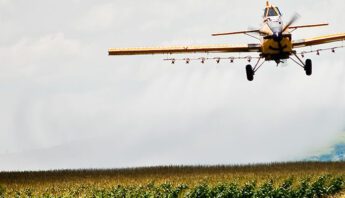Pesticide drift is not just a health issue. It can also cause significant financial problems for farmers growing sensitive crops. This spring, PAN lobbied alongside a growing coalition of farmer organizations in Iowa to promote solutions to the economic issues presented by drift. The Iowa state legislative session just wrapped up, and it looks like a small victory for these farmers might be just around the corner.
Being drifted on can be a huge setback for organic farmers and other specialty crop growers. It can mean less product to provide loyal customers, surprisingly high financial losses per acre and for organic growers, loss of certification. This was the second year our farmer-led coalition pressed for stronger rules for reporting and responding to drift, as well as more agency support for farmers facing crop damage from drifting pesticides.
Common sense solutions
When Iowa farmers first came together a few years ago to share concerns about the economic harms of pesticide drift, they made a long list of improvements that could be made to current policies governing pesticide application. One of the most pressing for these farmers was the complex process they must go through once they have been drifted on. Reporting to the Iowa Department of Agriculture Land Stewardship (IDALS) can be a long and confusing task — sometimes involving up to nine months of wait time before receiving test results of their drift damage samples.
Two of the common-sense improvements these farmers proposed were: 1) An improved drift incident reporting system that includes an option to report online; and 2) Faster turnaround time for pesticide residue sample testing.
Online reporting would let farmers report right away in non-peak farming hours, and be assured that all the information they submit stays in their incident file. Speedier test results would give them the quick information they need to decide how to deal with their contaminated crops. IDALS currently has the administrative power to make these changes, so last year the coalition submitted a formal request to the agency, asking them to create these new rules. Unfortunately IDALS rejected the proposal, forcing the coalition to go a legislative route to seek solutions to pesticide drift.
Unnecessary roadblocks
IDALS continued to oppose the proposal in its legislative form. Their frustrating response was that pesticide drift is not a problem for farmers, despite repeated farmer testimony to the contrary.
Their position leaves me to wonder who IDALS isn’t including in the category “farmer.” I know that Iowa is a corn and soy state, but it is also a growing producer of organic grain and other specialty crops. These are critical markets to expand in the state, as they are both profitable for farmers and support the growth of much-needed local food systems and thriving rural economies in Iowa. Don’t these farms deserve support and protection too?
Both last year and this year, the statewide coalition — which includes Iowa Farmers Union, Iowa Organics Association and the Women, Food, and Agriculture Network, along with PAN — has lobbied for these changes to be adopted through the Iowa legislature. This year we had a successful lobby day and a well-attended subcommittee hearing. After the demonstrated dedication of farmers who testified in support of the measure, the bill passed out of the subcommittee, gaining bipartisan support and good momentum.
The good news
After seeing the success of our legislation, IDALS came back to the table to discuss a potential regulatory solution. The State Hygienic Lab in Ankeny, Iowa does quick turnaround pesticide residue testing for two other states. Our bill proposed that pesticide drift testing be moved to this lab. IDALS is currently working with the Hygienic Lab to come up with a solution to improve the turnaround time without legislation.
We’re excited to hear the final announcement, expected sometime next month. We’ll also continue to press for online incident reporting and other improvements to pesticide drift response and prevention. Stay tuned.








